The ZIP+4 code system, also known as the “plus-four code,” extended or full zip code, adds four additional digits to the standard ZIP code. The purpose is to narrow down a location within a delivery zip code area, possibly to a specific building, floor, or apartment suite.
This article explores ZIP+4 codes in the USA and similar “micro-postcodes” worldwide, including Ireland, the UK, the Netherlands, Canada, and Brazil. We will also explain when these micro-postcodes are necessary, when standard postal codes are enough, and how to find a full zip code.
Other nations have micro-postcode systems, like full zip codes, in addition to the ones mentioned. For example, Singapore, Israel, Malta, Cape Verde in Africa, and Argentina use these codes, too. Check out the chart for more countries that use micro-postcode systems.
Try Our ZIP Code Lookup Tool
Enter any ZIP code in USA
Need International Coverage?
Get access to location data from 247 countries.
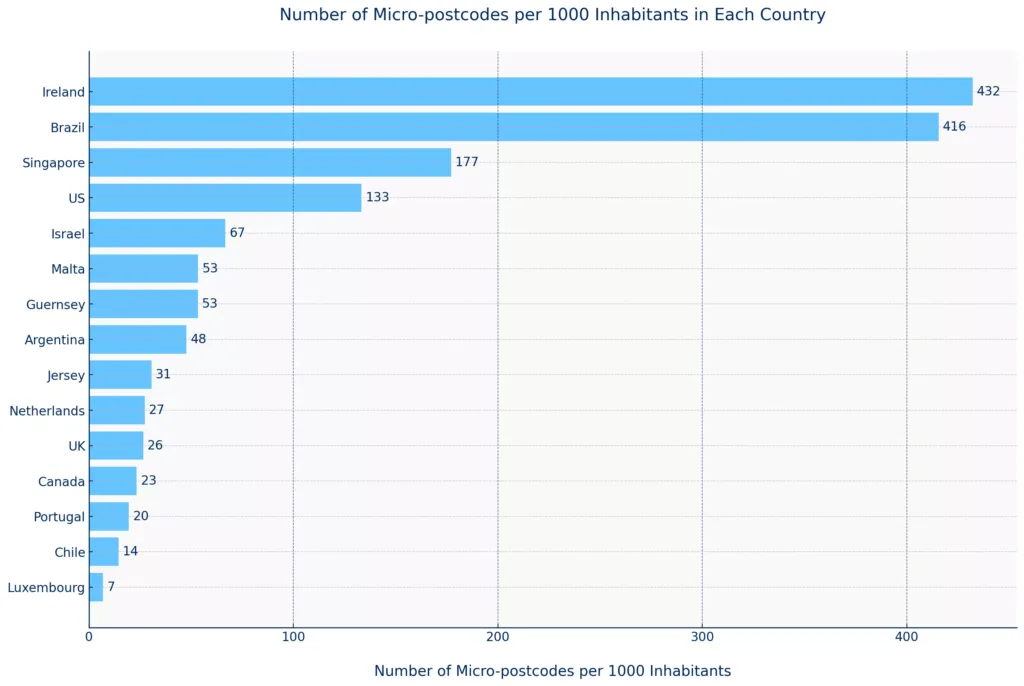
Why use ZIP+4 or a Full ZIP Code?
For locations with multiple delivery points within a single ZIP code, such as large office buildings, universities, or apartment complexes, ZIP+4 codes help ensure mail reaches the correct recipient.
This level of detail is essential in environments where multiple individuals or departments share the same basic address, as it significantly reduces the chances of mail being misdelivered. For instance, a university might use a full zip code to ensure that admissions documents reach the correct recipient immediately.
Do Businesses Need ZIP+4 Codes?
In business operations, standard ZIP codes are generally sufficient for validating addresses, market analysis, logistics optimization, and enhancing user experiences.
Many businesses find that standard ZIP codes meet their needs because they provide the necessary geographic information without the added complexity of ZIP+4 codes. The additional detail offered by ZIP+4 or a full ZIP code is often unnecessary for routine mailing tasks, making standard ZIP codes more convenient and easier for everyday business operations.
💡 For over 15 years, we have created the most comprehensive worldwide zip code database. Our location data is updated weekly, relying on more than 1,500 sources. Browse GeoPostcodes datasets and download a free sample here.
Full ZIP+4 code in the U.S.
To understand the structure of the ZIP+4 code, let’s break down the full ZIP Code of the White House, 20500-0004:
- The first five digits indicate the region, Sectional Center Facility (S.C.F.), and post office or delivery area (e.g., 20500).
- The sixth and seventh digits specify a smaller area, like a city block or large building.
- The eighth and ninth digits identify an exact location, like one side of a street, a specific floor, or an apartment.
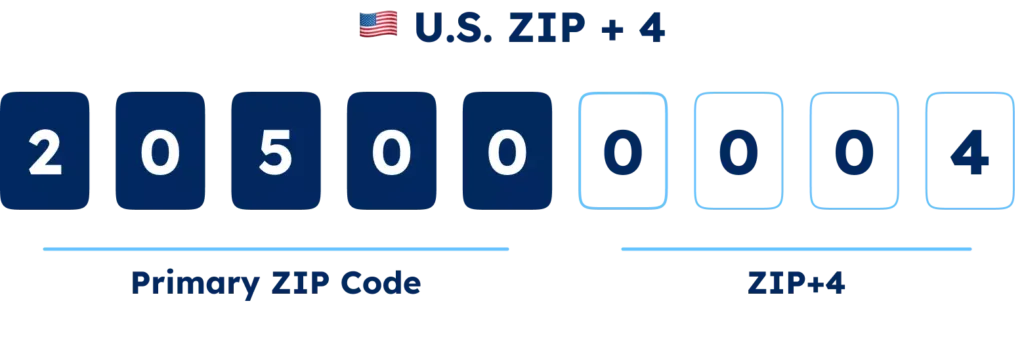
So, the full ZIP Code (ZIP+4 code) of the White House, 20500-0004, specifically designates region 2 (Washington, D.C. area), the S.C.F. 05 (Washington, D.C. central area), the post office or delivery area 00, the delivery sector 00, and the delivery segment 04.
The USPS ZIP Code™ Lookup Tool is a free web-based tool for finding a full ZIP code for a specific address or address range.
Micro-Postcodes Across The World
Ireland
Eircode, introduced in 2015, is Ireland’s national micro-post codes system. Each Eircode is unique to a specific address, meaning no two addresses share the same code. Each Eircode has a unique 7-character code, including letters and numbers. For example, the Eircode for the Irish Parliament is D02 XR20.

An Eircode has two parts:
- 3-character routing key that identifies the area.
- 4-character unique identifier for each address.
Every residential and commercial address in Ireland has an Eircode, including houses, flats, duplex units, and rural townland properties.
For example, consider two houses on the same street; each house has a distinct Eircode despite their proximity. Similarly, if houses have the same number on different streets in the same town, each house will have a different Eircode. This level of specificity ensures that mail is delivered to the correct address without confusion.
Eircodes help correct address mistakes by providing a unique code for every address in Ireland, ensuring accurate mail delivery even if the address is partially incorrect.
To find or verify an Eircode, use the Eircode Finder.
United Kingdom
The United Kingdom has approximately 1.7 million postcodes. This large number is due to micro-post codes, which allow for very granular geographical precision. These micro-post codes provide detailed location information, often specifying particular segments of streets.
A case in point is Buckingham Palace’s postcode: SW1A 1AA.

It uses two components to guide the mail: an outward code indicating the postal area or town and an inward code specifying the exact street or delivery point.
Each postcode usually covers about 15 properties but can include up to 100. Royal Mail’s postcode finder is a free web-based tool that allows users to find micro-postcodes for specific addresses or address ranges.
Netherlands
The postcode format in the Netherlands has four digits followed by two uppercase letters (e.g., 1234 AB). This format helps in precisely identifying addresses within the country. For a glimpse, the postcode for Anne Frank’s House is 1016 GV.
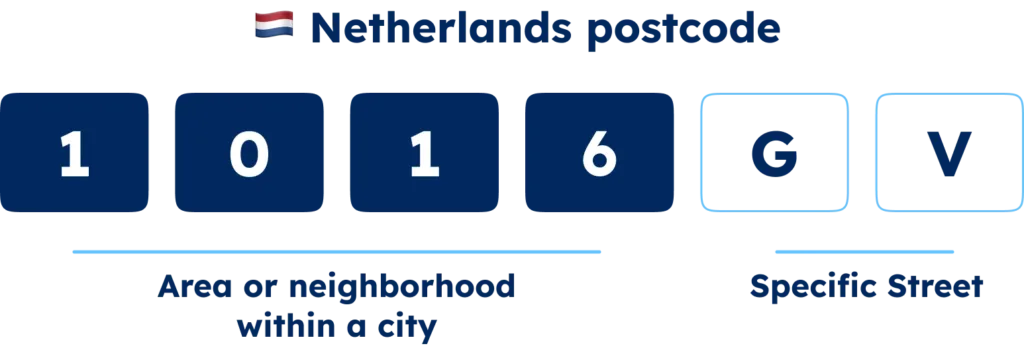
The digits represent a specific area or neighborhood, while the letters further narrow down the location, often to a specific street or part of a street. This system ensures that each postcode and house number uniquely identify an address. You can browse Netherlands micro-postcodes on the official Post NL website.
Canada
Canada‘s postal code system, introduced in 1971, uses a mix of letters and numbers. Each postal code is composed of six characters. An example is the postal code for Parliament Hill: K1A 0A9.
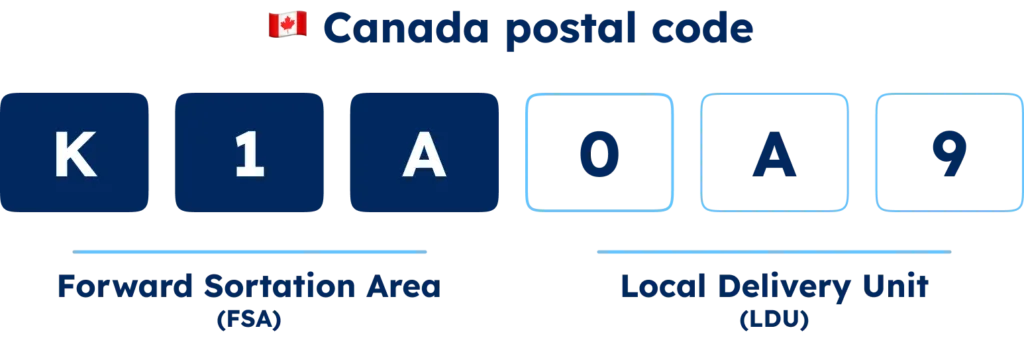
The first segment of the Forward Sortation Area (F.S.A.) shows a geographic region or specific community. The second segment, the Local Delivery Unit (L.D.U.), narrows down the delivery location to a particular address, street, or building. To find a micro-postcode for Canada, you can use the official Canada Post website.
Brazil
Brazil‘s postal code system, C.E.P. (Código de Endereçamento Postal), was introduced in 1971. Each C.E.P. is eight digits long and typically formatted as 12345-678. For example, the postal code for the iconic Christ the Redeemer statue is 22241-125.
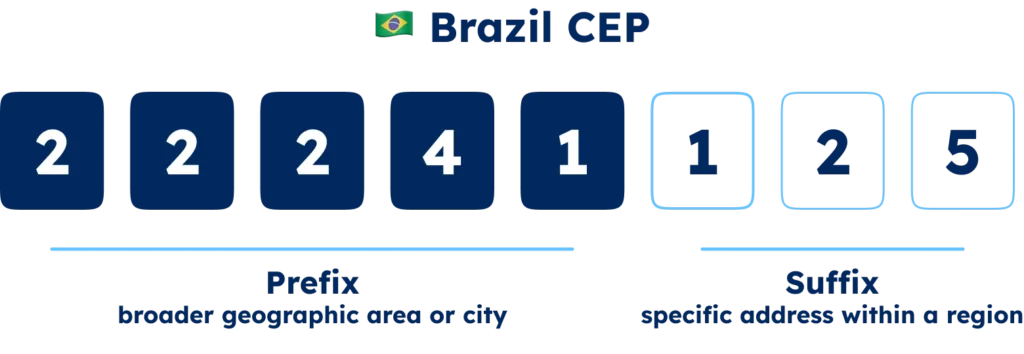
The first five digits represent a specific region, city, or neighborhood, while the last three identify the exact address or block. Use Brazil Postal Code Lookup to find micro-postcodes for Brazil.
Why is it essential to have accurate zip code data?
Whether using location data to validate addresses, analyze the market, optimize logistics, or improve user experience, you must ensure you have the most accurate and up-to-date zip code data.
Changes in zip codes regularly occur as cities grow, populations shift, and policies evolve. When operating a business in multiple countries, having accurate zip code data is crucial because the cost of inaccurate zip code data extends beyond direct expenses.
The United States Postal Service (USPS) estimates that undelivered mail due to inaccurate data costs U.S. businesses a staggering $20 billion. This figure underscores the financial risks companies face when their zip code data is outdated. Undelivered mail leads to lost revenue opportunities and undermines marketing efforts.
Consider this: direct mail campaigns typically yield conversion rates of around 2.9% for prospect lists.
If mail is undelivered due to inaccurate zip code data, businesses lose potential customers and the associated lifetime value those customers could have brought. This is a significant blow to any marketing strategy.
Undelivered transactional mail, such as bills and statements, can lead to delays in cash flow, increased customer complaints, and additional costs for handling late fees and collections.
Use Cases of Zip Codes
Consistent zip code data across different countries is necessary for businesses expanding to new markets or managing international assets.
A unified database of zip codes helps gain accurate customer insights, streamline supply chain operations, improve customer experiences, and make it easier to follow regulations.
To learn more about unified zip code data for global businesses, read our article, The 7 Challenges of Building a Standardized Zip Code Database.
Zip Codes also form valuable reference data for spatial analysis and all business operations requiring accurate location data. Below are use cases for zip codes:
Address Validation
Address Validation involves comparing the new address against a comprehensive and up-to-date database of valid addresses. This can be done in real-time (e.g., during online transactions) or integrated into backend systems to ensure that addresses are accurate before further processing.
Other vendors collect USPS information and resell it. The GeoPostcodes postal database differs from that of USA data by the additional features and services, such as multi-language support, geocodes, and time zone information.
Address Autocomplete
Address Autocomplete automatically suggests or completes address information in a form, reducing the risk of manual input errors. It helps you deliver superior user experience, increase conversion at checkout, and prevent shipping problems
Map and Visualization
You can create engaging, map-based visualizations to improve decision-making and understand geographic distributions. Check out our article on how to create a zip code map.
Reporting and Business Intelligence
Accurate zip code data ensures your reports are accurate and consistent across the organization. Enhance your data analysis with robust location intelligence to drive better business outcomes.
Master Data Management
Using accurate zip code data in master data management, you rely on a single source of truth to improve the quality of your location data. Ensure data accuracy, consistency, and timeliness across all your systems and organizational processes.
Logistics and Supply Chain
Regarding logistics and supply chain design, zip code data enables you to optimize your distribution networks, plan pick-up, and drop-off locations efficiently, reduce operational costs, and gain better visibility over shipping processes.
Sales & Marketing
Segment your customers effectively, design targeted sales areas, and execute focused marketing campaigns. Use zip code data for business strategies to enhance retail analytics, geomarketing, and market research.
If you’re looking to discover more ways to leverage ZIP code data for enhanced business insights and efficiency, explore how to add geocoded ZIP codes to Salesforce, ensure accuracy with address validation in Microsoft Dynamics 365, create impactful visuals by mapping ZIP codes in Tableau, and optimize logistics by calculating distances between ZIP codes using Python.
How to Get Zip Code Data?
Options are:
- Use open-source data
- Build an in-house solution
- Buy zip code data from a commercial solution
Using open-source zip code data
Open-source zip code data are generally helpful but often fall short in accuracy and completeness. Here are some examples of open-source data:
OpenStreetMap (O.S.M.)
OpenStreetMap (O.S.M.) is a popular open-source mapping platform where volunteers contribute to geographic data worldwide. This includes data on roads, buildings, and zip codes. While O.S.M. is helpful, the data quality can vary.
In cities, coverage is usually great because more users contribute. However, in rural or less developed areas, the data might be incomplete or outdated, leading to gaps in zip code information.
OpenStreetMap does not always have the most complete and up-to-date zip code data. As a result, you could be missing postcodes. Some OpenStreetMap postcodes should be discarded altogether, as they don’t respect the country’s postcode format.
Python Libraries: Pyzipcode and Uszipcode
Pyzipcode and Uszipcode are highly similar in coverage (U.S.A.) and features. They include a list of zip codes and associated properties, such as the town they belong to or coordinates.
The uszipcode library has a few more features and data sources. It also provides two different databases: simple and rich.
The simple database contains basic information about zip codes, such as city, state, latitude, longitude, etc. The rich database contains more detailed information, such as population, housing, income, etc.
The uszipcode library also provides a search engine that allows us to query zip codes based on various criteria, such as city, state, radius, population, etc. These are convenient but not updated frequently.
Another problem is the inconsistency in data formats across different sources. Countries and organizations often use different geographic and postal data formats, making combining and standardizing everything tricky.
💡 Use accurate zip code data in global operations. At GeoPostcodes, our zip code data is updated weekly, relying on more than 1,500 sources. Browse our datasets and download a free sample here.
Building an in-house international zip code database
For a company that operates in multiple countries, the process involves combining multiple datasets into one coherent and homogeneous model to build such international data. Different countries use different formats for their postal data, adding complexity to the aggregation process.
You can use tools such as PostgreSQL / PostGIS and Python (Pandas / Geopandas, PolarRS) to build a standardized zip code dataset. By following the below steps:
- Find and catalog data sources
- Design your data model
- Pre-process your data source and extract relevant information
- Link to administrative divisions
- Geocode your new data
- Link postal data with other standards
- Assess your aggregated data quality
To learn more about this process, check out our article on The 7 Challenges of Building a Standardized Zip Code Database.
Buy international zip code database
If you need the data for one country, it might still be manageable with open-source databases. But the process is hard enough for a couple of countries. If you need quality data for several countries, outsourcing those efforts to a trustworthy data provider will save you time and money.
At GeoPostcodes, we have already set up all these processes to aggregate postal data for more than ten years. We ingest over 1500 data sources to build our worldwide databases.
All the data is cleaned, normalized, and pushed to a unified data model. We track postal and administrative changes, link to several external sources (e.g., geocodes, UNLOCODES, time zones), and publish weekly updates.
We will also answer your questions about national administrative and postal structures as we aggregated and curated all that data.
Conclusion
In conclusion, micro-postcodes like ZIP+4 codes in the U.S. offer exact address identification, breaking down regions into specific segments such as buildings or apartments.
Other countries have similar systems: Ireland’s Eircode, the U.K.’s detailed postcodes, the Netherlands’ numeric and alphabetic postcodes, Canada’s alphanumeric postal codes, and Brazil’s eight-digit C.E.P.
In scenarios like university campuses with multiple departments or offices sharing the same address, micro-postcodes such as ZIP+4 are important. These codes provide detailed location information, ensuring that mail is delivered accurately to specific floors or departments within the campus.
This precision reduces the risk of delays in critical communications, such as admissions documents reaching the correct office.
In contrast, standard five-digit zip codes are sufficient for business use cases. These codes provide adequate geographic information for address validation, market analysis, and logistics.
They balance accuracy and simplicity, making them suitable for routine business operations where the additional granularity of ZIP+4 or similar systems is unnecessary.
With more than 15 years of experience, we offer the most comprehensive, accurate, and up-to-date geocoded zip code data. Browse GeoPostcodes datasets and download a free sample here.
FAQ
Does the USPS require ZIP+4?
No, the USPS does not require ZIP+4 codes. While the United States Postal Service (USPS) does not enforce the mandatory use of ZIP+4, incorporating this 4-digit extension into the traditional 5-digit ZIP code serves to define a more specific delivery trajectory within a carrier route.
This enhancement significantly boosts the efficiency and accuracy of mail delivery.
The integration of ZIP+4 results in expedited delivery speed and elevates the level of precision, ultimately ensuring a more seamless and reliable postal experience for both senders and recipients.
How do I find the extra 4 digits of a ZIP code?
Accessing the full 9-digit ZIP code tapestry through the U.S. Postal Service’s free ZIP+4 code lookup tool involves a simple and user-friendly process.
Users can input detailed address information into the online tool, and it will provide the most precise and up-to-date ZIP+4 code for any specific location.
This tool is an essential resource for optimizing the postal delivery process, allowing users to incorporate the accurate 4-digit code for increased delivery efficiency and reliability.
Is ZIP+4 important?
Yes, ZIP+4 codes are important because they help the USPS sort and deliver mail more efficiently, ensuring quicker and more accurate delivery.
What are the NYC ZIP codes?
New York City has numerous ZIP codes, with ranges such as 10001-10292 in Manhattan, 10451-10475 in the Bronx, 11201-11256 in Brooklyn, 11101-11109 in Queens, and 10301-10314 in Staten Island.
Use the USPS ZIP Code Lookup for specific addresses.
How does the ZIP+4 code system enhance mail delivery efficiency?
The ZIP+4 code system enhances mail delivery efficiency by adding four digits to a standard street address, refining the sorting and delivery process.
These additional numbers narrow down the given zip code to a specific delivery route, such as a particular building or apartment within the area covered by the full zip code.
What benefits do the additional numbers in a ZIP+4 code provide?
This precision allows the local post office to manage mail more effectively, ensuring accurate and timely delivery.
Plus four codes play a crucial role in directing mail to specific locations, handled by the particular post office in charge of that region.
How does the ZIP+4 system support efficient mail sorting?
This system not only aids the local post office but also supports the efficient mail sorting and delivery process, ensuring every piece of mail is accurately routed according to its specific delivery route, enhancing overall mail system performance.
Why are zip codes important in the mail system?
The inclusion of zip code numbers and full zip codes ensures that every mail piece is correctly processed and delivered, highlighting the importance of precise addressing in the mail system.
How Can I Perform a Full ZIP Code Lookup?
A full ZIP Code lookup helps find the ZIP+4 code, which provides more precise location details. The ZIP+4 system includes:
- 5-digit ZIP Code
- 4-digit extension for specific addresses or mail routes
You can use USPS tools or online databases to find the full ZIP Code by entering an address. This improves address accuracy, speeds up mail delivery, and ensures proper address data management.
What Are ZIP Code Boundaries and the Expanded ZIP Code System?
ZIP code boundaries define geographic areas assigned to ZIP codes, but they don’t always align with city or county borders. The expanded ZIP Code system (ZIP+4) helps pinpoint specific locations within these boundaries.
The ZIP+4 code enhances address data management by reducing delivery errors and improving efficiency. Businesses use ZIP+4 for geolocation, service coverage, and routing accuracy. Checking ZIP code boundaries ensures correct addressing and delivery.



